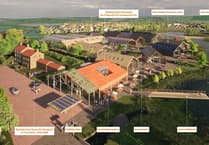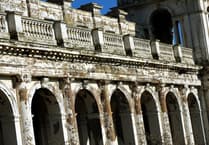THIS Forest View is about forest views from Cinderford to Newnham.
On the road from Cinderford to Littledean, when conditions are right, there are glorious views of Gloucester Cathedral, and the unromantic sounding Javelin Park Incinerator looks almost as impressive from 10 miles away.
From Littledean to Newnham you can take a short detour to the Forest site Blaize Bailey, just a short walk from the car parking area.
The trees planted a year or so ago just below the Blaize Bailey lookout platform have now grown so much that they obscure views close to the village, but above these trees you can still see the Arlingham meander of the Severn as it loops round towards Newnham.
There are great views of the Severn bore from there, and I think that sometime in the next few centuries an exceptionally high bore, with strong south westerlies from the Atlantic, will ignore the Arlingham loop, swamp the narrow isthmus, cut off a couple of miles of meander and surge on direct to Gloucester.
The river will thereafter flow from Rodley to Awre avoiding Newnham completely. From the present river course will be created the ox-bow lake that I learned about in GCE Geography many years ago (before GCE became GCSE), and Arlingham will be transferred to West Gloucestershire. Don’t say I didn’t warn you.
And down into Newnham there is the village green, on the highest point of the village, where here was a Norman castle that has left no traces, and some English Civil War field works.
From here you can see the former river port at Collow Pill, with its diminutive lighthouse, the downstream Severn, the ancient church, rolling hills and the occasional train travelling through peaceful meadows.
We are reminded by the useful signage at the site that on this spot a Civil War skirmish took place.
The Civil War on this side of the river seems to have been a private quarrel between Colonel Massey (Parliamentarian, Gloucester) and John Wintour (Royalist, Lydney).
They spent much of the war chasing each other up and down the Severn and burning each other’s churches.
Wintour was holding out against Massey at Newnham.
The area was defended by steep slopes to the east and west, and by the Severn to the south.
This was a dominant defensive position, but Massey unsportingly attacked from the undefended north and took the town from the royalists.
If you listen carefully and with some imagination, you may hear the faint battle cries and clashes of steel on steel from all those years ago as you visit the pleasant village historical site.
Massey of course ended up on the winning side in the Civil War, but Wintour managed to survive the war, evading capture at what became known as Wintours Leap, at Boughspring, where he somehow descended from the high cliff over the River Wye to his rescue boat below.
There are great views of the Wye at that point, but I suspect that John Wintour was too preoccupied to enjoy them.




